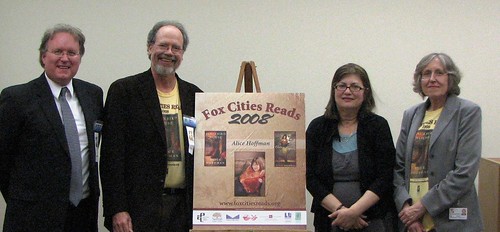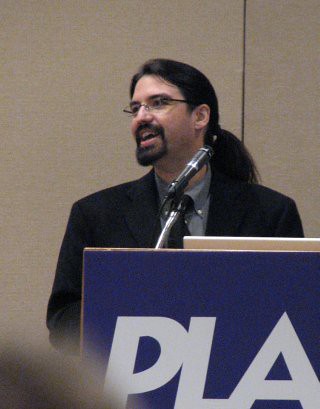On her excellent
Fox Politics site, local political activist Jo
Egelhoff published a posting
"From Lon Ponschock: Nix cell phone use at the library." Lon is spearheading a movement to have cell phones excluded from the Appleton Public Library. Because Jo's blog is influential and widely read, I had several contacts from Library Board members, and I posted an extensive response. Jo asked me to revise my posting in 600-700 words, and I submitted the following:
700 wordsAt the next meeting of the Appleton Public Library Board of Trustees, at 4:30 PM May 13, the Board will discuss cell phone use in the Library. The fact that this topic is generating so much heat is indicative of problems both with the current facility and social change lagging behind technological change.
The Library’s Rules of Conduct Policy states: “Patrons of the Appleton Public Library have the right to use Library materials and services without being unduly disturbed or impeded by others.” In a world that sometimes seems to have too many rules, this is a good policy: we don’t want people to get in each other’s way.
But social ambiguities are exacerbated by new technology; cell phone use is poorly socialized, and sometimes may seem trivial. But I got my cell phone when my parents became ill and needed to stay in touch. I get urgent calls from work. Some library users contact employers or others to share information found at the library, and children need to remain in contact with parents. Pay phones are disappearing. Cell phones are part of life and we need to deal with them.
Movie theaters remind audiences several times to silence phones. Our phones seductively remove us from our physical environment and into virtual space. This leads to car accidents and conversations in the middle of movies. Particularly in places where physical neighbors represent no real relationship or emotional investment, we may not notice ourselves being anti-social. This is inconsiderate, but happens too often – especially in airports.
We should keep up dialog and education. Most people are not intentional jerks, but can easily be heedless. Social problems suggest social solutions: “Excuse me, you’re being rather loud; could you please hold it down?” If rudeness does not respond to courtesy, it’s time to call in the authorities.
Courteous folks turn off ringers in shared space and are sensitive to others, not taking phone calls in the theater or in church. Public libraries are different. They
aren't spaces where everyone is presumed to sit quietly and pay attention to the same thing, but where everyone is doing their own thing. People talk at the Appleton Library all the time, especially on the first floor, designed as a louder, more social area. In any case, people on phones would be courteous to step away from others, creating some physical space, and keep their voices low.
Library staff sometimes ask people to hold conversations down, control their kids, or take their phone call downstairs. We remind people not to sing along with their
iPods. In the scheme of things, we get more complaints about several other behavioral problems than about people using cell phones on the first floor. But we deal with these case by case. We appreciate it if people stick up for themselves: a concern often means more coming from peers than from authority. It’s about community, not rules.
We ask people to silence ringers when they enter the library, keep phone conversations low volume and prohibit cell phone use on the second floor – about half the library and a majority of adult public service space. We think this a reasonable compromise between the many people who want to use cell phones and those who don’t want to have to hear other people’s conversations – even quiet ones.
As our library has become more crowded and has less seating, the problem has gotten worse. In the long run, I would like to see a library better designed to allow separate places – difficult in a big “open concept” building. I love libraries with study rooms, big reading rooms and quiet nooks that feel like living rooms.
Lacking better designed space, what should the Appleton Public Library do about cell phones? To me, a total ban is an over-reaction to a small problem, but that’s the question for the Library Board. As the citizen group charged with representing the interests of the community, they have the governing authority to set policy. This is a tough call, balancing diverse interests and opinions. While Appleton’s current practice is actually pretty typical for Fox Cities libraries and comparable communities around the state, the Board will decide.
--
Post Script:
Reviewing this, I thought of a few more points, beyond what I squeezed into 700 words. Concise is not my bag, alas.
- I'm really proud of the job the library staff does working to keep the place nice and enforcing policies where needed. The fact they are able to keep up as well as they do, despite increasing workloads, speaks well of them -- and of most of our users
- One of the responses on Fox Politics was by a Dave Allen, who wrote that the library is like a church:
No one would think of using a cell phone in church where reflection and worship is the purpose and no one should think of using a cell phone in a library where worship of thought and research and knowledge is the purpose.
I like this a lot, even though I have to partly disagree. The library is most like a church in some ways, and I think we do provide places of quiet reflection. Like a church, the library offers spiritual values and transforming power. But the library is also a happening place with live music performances offered at times on the main floor, lots of families with kids, and lots of lively discussions. The research area is where cell phones are banned, but I don't want to go back to "Grandma's library" where everybody gets shushed. I think there's room for the library to meet a more diverse set of needs. - It was almost forty years ago that the Wilson Library Bulletin published its famous and highly debated pull-out centerfold, the "NO SILENCE" sign. The controversy is still with us. Art Plotnick, the visionary who masterminded the idea, wrote in 1972:
...don't you know, sisters and brothers, it is as a storage place that the library is going to die. For in a world grown - that's right - increasingly raucous and cacophonous, the critical, instant information, communication, and education that the non-elite among us will need to survive will not come from the soft rustle of pages and the quiet stir of thoughts. Save all that for those who have already made it, working in the university libraries, the law and medical libraries, the scholars' archives. But try to sell a people's library on the appeal of slanting falls of light - and, honey, that light got to fall on empty chairs. And then you'll have your silence.
- So let's make space for some more quiet reading rooms -- by all means. But let's not try to turn back the clock. Whether or not they allow cell phones -- and I believe most do -- public libraries should be places where we can enjoy some quiet, but also be part of an active community. NO SILENCE.


















